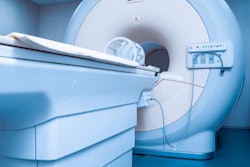
The average age of the installed base of MRI scanners in the U.S. grew from 8.7 years in 2010 to 11.4 years in 2013, meaning that many scanners could be due for a replacement, according to a new market research report by IMV Medical Information Division.
With the last spike of new MRI installations taking place from 2002 to 2004, the market is ready to replace older units that are at the end of their useful lives, said Lorna Young, senior director of market research at IMV, in a statement. Imaging providers also plan to take advantage of the wider bore sizes and higher magnet field strengths that are now available, she said.
IMV surveyed 450 MRI administrators nationwide; responses were extrapolated to the universe of 7,845 short-term general hospitals and imaging centers in the U.S. that use fixed MRI systems or mobile service providers to perform MRI.
In other survey results, 20% of all MRI users said they plan on purchasing a new system in the next three years, which is down slightly from the 22% of MRI users reported by IMV in 2012. An additional 24% of users indicated they would "maybe" purchase a new unit, representing a significant but less certain potential market for MRI systems.
IMV noted that the larger hospitals with more than 200 beds and their associated imaging centers are the main purchasers of MRI systems. Independent imaging centers have been hit particularly hard by the economic slowdown and are concerned with managing their bottom line.
Survey respondents from imaging centers were more likely than hospital respondents to feel that reductions in Medicare and third-party reimbursements were causing their MRI revenue to decline in 2013. As a result, only 20% of the sites planning MRI system purchases are independent imaging centers, despite this category comprising 36% of MRI sites overall.
MRI department administrators are experiencing a number of pressures, such as dealing with falling reimbursements, managing prior authorization processes, maintaining department accreditation, and staying abreast of how changes in federal and state healthcare reform will affect their operations, IMV said. As they are dealing with these challenges, technology improvements that facilitate speed, broaden clinical applications to address referring physician needs, and improve patient comfort are driving the purchase criteria for MRI systems for those who are in buying mode.
IMV projects that three of every four new MRI installations will have wide-bore widths of 70 cm or larger. The mainstay of the modality is still 1.5-tesla units, which represent more than 70% of all recently installed systems. Interest in very-high-field MRI units continues to grow, however, with 3-tesla units making up more than one-quarter of planed purchases, IMV said.
More than 33.8 million MR procedures were performed in the U.S. in 2013, at 7,845 hospital and nonhospital locations. That's up 2.8% per year from the 32 million procedures reported in 2011, IMV said. However, respondents reported that lower reimbursement from both Medicare and third-party payors is leading to a revenue decline.
In clinical MRI trends, the major categories for MR procedures are spine, brain, and lower and upper extremity procedures. Together, these constituted 22.4 million studies, or two-thirds of the MR procedures performed in 2013.
The biggest growth areas, however, are breast, prostate, vascular (MR angiography), and pelvic and abdominal procedures, according to IMV. These grew in aggregate from 5.3 million in 2011 to 7.9 million in 2013, an increase of almost 50%.
The use of MR contrast media has stayed relatively constant over the years. MR contrast was used in 43% of MR procedures in 2013, compared with 41% in 2001 and 37% in 2011. Initial reaction to the U.S. Food and Drug Administration's 2009 labeling changes for gadolinium-based contrast agents to minimize the risk of nephrogenic systemic fibrosis (NSF) may have led to the dip in contrast utilization in 2011, but its use appeared to be returning to pre-2010 levels in 2013, IMV said.
Disclosure notice: AuntMinnie.com is a subsidiary of IMV Ltd.




.fFmgij6Hin.png?auto=compress%2Cformat&fit=crop&h=100&q=70&w=100)




.fFmgij6Hin.png?auto=compress%2Cformat&fit=crop&h=167&q=70&w=250)











